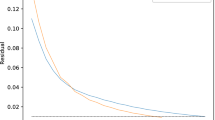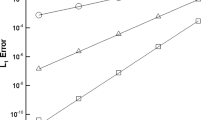Abstract
This study identifies the main factors influencing the load balancing for the SPH method. The idle rate is introduced as an index to quantify the load balancing. We present the algorithmic strategies of our implementation of the SPH method, and their impact on the load balancing. Also, it is shown for the SPH method that due to the formulations of the physics and its Lagrangian aspect, the load balancing can significantly vary during the simulation. Especially, spurious pressure fluctuations arising at boundaries affect the load balancing.
Access this chapter
Tax calculation will be finalised at checkout
Purchases are for personal use only
Similar content being viewed by others
References
S. Braun, Zur Simulation der Zerstäubung flüssigen Kraftstoffs mit der Smoothed Particle Hydrodynamics Methode. Logos Verlag Berlin GmbH (2018)
S. Braun, R. Koch, H.J. Bauer, Smoothed Particle Hydrodynamics for Numerical Predictions of Primary Atomization, pp. 321–336. Springer (2016). https://doi.org/10.1007/978-3-319-47066-5_22
S. Braun, L. Wieth, R. Koch, Bauer, A framework for permeable boundary conditions in SPH: Inlet, outlet, periodicity. In: Proc. of the 10th Internat. SPHERIC Workshop (2015)
G. Chaussonnet, S. Braun, T. Dauch, M. Keller, A. Sänger, T. Jakobs, R. Koch, T. Kolb, H.J. Bauer, Toward the development of a virtual spray test-rig using the smoothed particle hydrodynamics method. Comput. Fluids 180, 68–81 (2019). https://doi.org/10.1016/j.compfluid.2019.01.010
C. Höfler, Entwicklung eines Smoothed Particle Hydrodynamics (SPH) Codes zur numerischen Vorhersage des Primärzerfalls an Brennstoffeinspritzdüsen. Logos Verlag Berlin GmbH (2013)
J.J. Monaghan, Smoothed particle hydrodynamics. Rep. Prog. Phys. 68, 1703–1759 (2005)
Acknowledgements
The authors like to thank the Helmholtz Association of German Research Centres (HGF) for funding (Grant No. 34.14.02). This work was performed on the computational resource ForHLR Phase II funded by the Ministry of Science, Research and the Arts Baden-Württemberg and DFG ("Deutsche Forschungsgemeinschaft").
Author information
Authors and Affiliations
Corresponding author
Editor information
Editors and Affiliations
Rights and permissions
Copyright information
© 2021 Springer Nature Switzerland AG
About this paper
Cite this paper
Chaussonnet, G. et al. (2021). Influence of the Flow Physics on the Load Balancing During SPH Simulations. In: Nagel, W.E., Kröner, D.H., Resch, M.M. (eds) High Performance Computing in Science and Engineering '19. Springer, Cham. https://doi.org/10.1007/978-3-030-66792-4_31
Download citation
DOI: https://doi.org/10.1007/978-3-030-66792-4_31
Published:
Publisher Name: Springer, Cham
Print ISBN: 978-3-030-66791-7
Online ISBN: 978-3-030-66792-4
eBook Packages: Mathematics and StatisticsMathematics and Statistics (R0)




